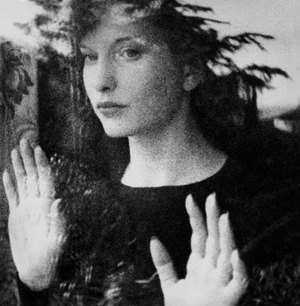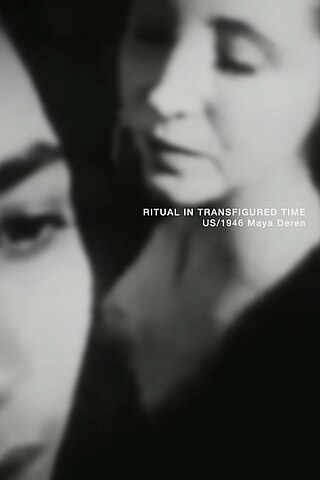Video art is an art form which relies on using video technology as a visual and audio medium. Video art emerged during the late 1960s as new consumer video technology such as video tape recorders became available outside corporate broadcasting. Video art can take many forms: recordings that are broadcast; installations viewed in galleries or museums; works either streamed online, or distributed as video tapes, or on DVDs; and performances which may incorporate one or more television sets, video monitors, and projections, displaying live or recorded images and sounds.

Meshes of the Afternoon is a 1943 American experimental silent short film directed by and starring wife-and-husband team, Maya Deren and Alexandr Hackenschmied.

Maya Deren was a Ukrainian-born American experimental filmmaker and important part of the avant-garde in the 1940s and 1950s. Deren was also a choreographer, dancer, film theorist, poet, lecturer, writer, and photographer.
Amos Vogel was a New York City cineaste and curator.
Cinema 16 was a New York City–based film society founded by Amos Vogel. From 1947 to 1963, he and his wife, Marcia, ran the most successful and influential membership film society in North American history, at its height boasting 7000 members.

Barbara Jean Hammer was an American feminist film director, producer, writer, and cinematographer. She is known for being one of the pioneers of the lesbian film genre, and her career spanned over 50 years. Hammer is known for having created experimental films dealing with women's issues such as gender roles, lesbian relationships, coping with aging, and family life. She resided in New York City and Kerhonkson, New York, and taught each summer at the European Graduate School.

Joan Jonas is an American visual artist and a pioneer of video and performance art, "a central figure in the performance art movement of the late 1960s". Jonas' projects and experiments were influential in the creation of video performance art as a medium. Her influences also extended to conceptual art, theatre, performance art and other visual media. She lives and works in New York and Nova Scotia, Canada.

Shirley Clarke was an American filmmaker.

Ralph Steiner was an American photographer, pioneer documentarian and a key figure among avant-garde filmmakers in the 1930s.
George Landow, also known as Owen Land, was a painter, writer, photographer and experimental filmmaker. He also worked under the pen names Orphan Morphan and Apollo Jize.

Alexandr Hackenschmied, born Alexander Siegfried George Hackenschmied, known later as Alexander Hammid, was a Czech-American photographer, film director, cinematographer and film editor. He immigrated to the U.S. in 1938 and became involved in American avant-garde cinema. He is best known for three films: Crisis (1939), Meshes of the Afternoon (1943) and To Be Alive! (1964). He made Meshes of the Afternoon with Maya Deren, to whom he was married from 1942 to 1947. His second marriage was to the photographer Hella Heyman, who had also collaborated with Hammid and Deren on several films.

Henry Wessel was an American photographer and educator. He made "obdurately spare and often wry black-and-white pictures of vernacular scenes in the American West".

Janet Collins, OblSB was an African American prima ballerina, choreographer, and teacher. She performed on Broadway, in films, and appeared frequently on television. She was among the pioneers of black ballet dancing, one of the few classically trained Black dancers of her generation.
Talley Beatty was born in Cedar Grove, Louisiana, a section of Shreveport, but grew up in Chicago, Illinois. He is considered one of the greatest of African American choreographers, and also bears the titles dancer, doctor, and dance company director. After studying under Katherine Dunham and Martha Graham, Beatty went on do solo work and choreograph his own works which center on the social issues, experiences, and everyday life of African Americans. Beatty and his technique and style of dancing were both praised and criticized by critics and dancers of his day.

The Film-Makers' Cooperative is an artist-run, non-profit organization founded in 1961 in New York City by Jonas Mekas, Andy Warhol, Shirley Clarke, Stan Brakhage, Jack Smith, Lionel Rogosin, Gregory Markopoulos, Lloyd Michael Williams, and other filmmakers, for the distribution, education, and exhibition of avant-garde films and alternative media.
Annette Michelson was an American art and film critic and writer. Her work contributed to the fields of cinema studies and the avant-garde in visual culture.
Leonor Antunes is a Portuguese contemporary artist who creates sculptural installations. She lives and works in Berlin.

Ritual in Transfigured Time is a 1946 American experimental silent short film directed by Maya Deren. Like Deren's previous work, A Study in Choreography for Camera (1945), she explores the use of dance on film through the lens of commentary of societal norms, metamorphosis, and anthropomorphism. The film is notable for its disjointed storytelling and use of slow motion, freeze framing, and unique blend of stage dance and film.
Edin Velez is a Puerto Rican video artist, director and professor. He is best known for his work on the documentary films State of Rest and Motion and Dance of Darkness.











